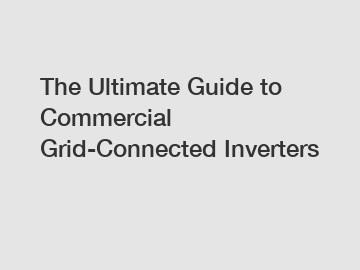The Ultimate Guide to Commercial Grid-Connected Inverters
## The Ultimate Guide to Commercial Grid-Connected Inverters.
### What are grid-connected inverters?
Grid-connected inverters are devices that convert the direct current (DC) generated by solar panels or other renewable energy sources into alternating current (AC) that can be used to power electrical devices and appliances in buildings. These inverters are essential components of grid-tied solar power systems as they enable the integration of renewable energy into the existing electricity grid.

### How do grid-connected inverters work?
Grid-connected inverters work by synchronizing the AC output with the utility grid's frequency and voltage levels. When the solar panels generate DC electricity, the inverter converts it into AC electricity that matches the grid's characteristics. The inverter also monitors the grid's status to ensure that it is safe to connect and feed electricity back into the grid.
### What are the types of commercial grid-connected inverters?
There are several types of commercial grid-connected inverters available, including central inverters, string inverters, and microinverters. .
- **Central inverters:** Central inverters are designed for large-scale commercial solar installations. They are typically placed in a central location and connected to multiple strings of solar panels. Central inverters are cost-effective and efficient for systems with a high number of solar panels.
- **String inverters:** String inverters are connected to multiple solar panels in series to convert DC electricity into AC electricity. They are suitable for commercial installations with less shading or panel orientation issues. String inverters are cost-effective and easy to install.
- **Microinverters:** Microinverters are installed on each solar panel to convert DC electricity into AC electricity at the panel level. This design allows for optimal performance even in partially shaded conditions and provides individual monitoring of each panel. Microinverters are suitable for commercial installations with space constraints or shading issues.
### What are the key considerations when choosing a commercial grid-connected inverter?
When selecting a commercial grid-connected inverter, it is essential to consider factors such as system size, efficiency, durability, monitoring capabilities, and warranty. Depending on the specific needs of the commercial solar project, different types of inverters may be more suitable. It is important to work with a reputable solar installer to design a system that meets the project requirements and maximizes energy production.
Want more information on OEM solar inverters manufacturer, oem inverters manufacturer, single phase to 3 phase inverters? Feel free to contact us.

Comments
0